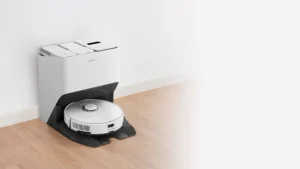Wondering how long do robot vacuums last? Quick answer. 3-5 years of daily use. But let’s have some fun with this.
Introduction: The Unsuspecting Energizer Bunny of the Cleaning World
Picture this: It’s a quiet evening at home, and you’re peacefully sipping your favorite beverage while reclining on the couch. Suddenly, a low hum fills the room, and out of nowhere, your trusty robot vacuum springs to life. It zips around like it’s possessed by an otherworldly cleaning spirit, tirelessly sucking up every speck of dust in its path.
Hours pass, and you start to wonder if this marvelous machine will ever quit. Spoiler alert: it won’t.
The Case of the Indestructible Robot Vacuum
I have witnessed firsthand the unyielding resilience of these robotic marvels. A friend once confessed that they had owned their robot vacuum for a solid decade – yes, you read that correctly – ten whole years! I was astounded.
In a world where smartphones become obsolete within months and fashion trends change as frequently as the weather, how could this unassuming cleaning gadget stand the test of time? It turns out; not all robot vacuums are created equal.
Some are built with such sturdy craftsmanship that they seem to possess an eternal lifespan. They endure bumps into furniture legs like fearless gladiators in an arena, boldly navigating obstacle courses without faltering.
A Robot Vacuum’s Secret Weapon: The Power of Stubbornness
As I delved deeper into this mystery (armed with curiosity and one too many cups of coffee), I discovered that these mechanical cleaning warriors thrive on stubborn determination. They scoff at exhaustion or weariness; they refuse to surrender until every nook and cranny has been rendered pristine.
Imagine those movie characters who keep getting up after being knocked down repeatedly – Rocky Balboa comes to mind – well, that’s the essence of a robot vacuum. They may stumble over a pesky power cord or get entangled in a stray shoelace, but they’ll shake it off and persist in their mission to vanquish dirt and debris from your floors.
When Worlds Collide: Robot Vacuum vs. Immortality
Now, let’s address the elephant-sized question in the room: can robot vacuums achieve true immortality? Well, my dear readers, while I’d love to entertain such fantastical notions, I must confess that even these ironclad warriors eventually reach their mechanical twilight years. But fret not! For the average lifespan of a robot vacuum ranges from three to five years – an impressive feat considering their relentless work ethic. In the following sections, we shall explore the intricacies of these tireless cleaning companions and uncover how their longevity might be influenced by factors such as usage frequency and maintenance. So sit back (or recline if you haven’t yet) and prepare for an exploration into the realm of robotic durability!
The Basics: Robot Vacuums 101
Suck It Up, Buttercup: Explaining What Robot Vacuums Are and How They Work
Picture this: a tiny, sleek machine that scuttles around your home, relentlessly sucking up every crumb, dust bunny, and stray hair in its path. That’s right folks, we’re talking about robot vacuums!
These nifty devices are a godsend for the perpetually lazy and woefully busy. Gone are the days of lugging around a clunky vacuum cleaner like it’s some kind of medieval torture device.
No more wrestling with cords or stumbling over them like an accident-prone klutz. These robotic marvels are designed to navigate your living space with ease, effortlessly gliding under furniture and reaching those dreaded nooks and crannies that have been haunting your cleaning nightmares.
Robots on a Mission: The Convenience and Time-Saving Capabilities
Let’s face it—cleaning is about as exciting as watching paint dry or sitting through an infomercial marathon. But fear not!
Robot vacuums swoop in to rescue us from the clutches of mundane household chores. These turbo-charged dust busters boast an array of features to make our lives easier than ever before.
Imagine programming your trusty robot sidekick to clean while you sip a margarita by the pool or catch up on the latest season of that guilty pleasure reality show (no judgment here). With their advanced sensors and smart mapping capabilities, these robots efficiently tackle each room of your home without any intervention from you—unless they encounter a particularly stubborn mess that requires some good old-fashioned human assistance.
But wait, there’s more! Some robot vacuums even have Wi-Fi connectivity and smartphone apps that let you schedule cleanings remotely.
You can be chilling at your favorite coffee shop, sipping on a triple-shot soy latte, and command your robot vacuum to start cleaning the moment you step foot through your front door. Talk about a modern-day miracle!
So say goodbye to laborious vacuuming sessions and embrace the future of cleaning with open arms. The robots have arrived, and they’re here to liberate us from the clutches of household drudgery, one dust bunny at a time.
The Lifespan of Robot Vacuums: Setting Realistic Expectations
So, you want to know how long these little robotic wonders can last? Well, let me break it down for you.
Ah, the lifespan of robot vacuums – a topic that perplexes many. You see, dear reader, these marvelous contraptions aren’t designed to be lifelong companions like some mythical vacuum unicorns. No, no! They have a more realistic expiration date – typically around 3-5 years. Now, I know what you’re thinking. “But I’ve seen robot vacuums on TV that claim to last forever!” Ah, my naive friend, those are just marketing gimmicks born out of desperation to make you part with your hard-earned cash. We live in an era where even our smartphones can’t seem to endure a single drop without shattering into pieces; do robot vacuums stand any chance?
Factors that Can Affect Their Longevity
Let’s talk about usage frequency first. Imagine running marathons every day while carrying a hefty backpack full of dust and debris.
That’s precisely what some robot vacuums go through when they are expected to clean multiple times a day in homes with kids and pets running amok. Naturally, this relentless wear and tear can take its toll on even the most robust robotic cleaner.
So if you’re planning on using your little vacuum buddy like there’s no tomorrow (or at least until all the floors gleam), brace yourself for the inevitable moment when it throws its digital hands up in surrender. But hold on!
It’s not all doom and gloom here. Remember that maintenance thing we mentioned earlier?
Yes, my friend – caring for your robot vacuum is vital for its longevity. Neglecting regular maintenance is like disregarding your own health while feasting on a diet of deep-fried Oreo cookies.
Trust me, it won’t end well for either party involved. Cleaning the robot vacuum’s brushes, emptying its dustbin, and replacing filters are the equivalent of giving it a spa day – a little pampering to keep it going strong.
Neglect this routine, and you’ll find your once efficient machine will transform into a zombie-esque vacuum that moves aimlessly around the house with dusty remnants trailing in its wake. So there you have it: setting realistic expectations for the lifespan of robot vacuums.
Remember, they may not be immortal beings, but with proper care and understanding of their limitations, they can be reliable cleaning companions for a good few years. So go forth now, armed with knowledge and humorously tidy floors!
The Tortoise or the Hare? Slow vs Fast Cleaners

Deliberate and Thorough vs. Speedy and Shoddy: A Vacuum Battle Royale
Ah, the eternal dilemma of choosing between the tortoise and the hare when it comes to robot vacuums! On one side, we have those painstakingly slow crawlies that take their sweet time to ensure every speck of dust is obliterated. And on the other side, we have those speed demons that zoom around like caffeinated hamsters, leaving half-hearted cleaning trails in their wake. It’s a battle between thoroughness and efficiency, my friends. Let’s start with the sluggish ones, shall we? These meticulous vacuums move at a pace that can only be described as glacial. They carefully navigate through every nook and cranny, ensuring not a single dust mite escapes their mighty suction powers. But boy oh boy, do they take forever to finish cleaning! You could watch an entire season of your favorite TV show while waiting for them to complete their mission. Patience is indeed a virtue when it comes to these diligent but dreadfully slow cleaners.
On the other end of the spectrum are those speedy whirlwinds that zip around like they’re auditioning for a high-octane racing movie. They cover more ground in minutes than their sluggish counterparts do in hours. However, here’s where things get tricky: speed often comes at the cost of effectiveness. These turbo-charged vacuums might be lightning-fast at picking up larger debris but tend to leave behind smaller particles and dust bunnies as if they were making an avant-garde art installation. Now let me regale you with some funny anecdotes about these robotic cleaners from both ends of the spectrum! Picture this: your slowpoke vacuum has been ambling along for what feels like an eternity when it comes to a rug fringe. It suddenly decides to wage war against this seemingly harmless decor and gets entangled, making you wonder who’s the real villain here: the vacuum or the rug? And let’s not forget the speed demons that think they’re Formula 1 racers. They leave no dust bunny unscathed, but in their haste, they occasionally ram into furniture like overzealous bumper cars, turning your living room into a demolition derby.
My dear readers, when it comes to choosing between slow and steady or fast and furious robot vacuums, it all boils down to your priorities. If you value meticulous cleaning and have the patience of a Zen master, opt for the tortoise-like cleaners. But if time is of the essence and you don’t mind occasionally playing hide-and-seek with wayward dust bunnies, go for the hare-like cleaners. Remember, in this battle between speed and thoroughness, there are always amusing tales to be told!
Tips on how to extend the lifespan of your robot vacuum
Keep your robot vacuum happy and it will keep your floors clean! Alright, folks, listen up!
If you want your trusty robotic buddy to stick around for the long haul, you better treat it right. Just like any relationship, maintenance is key.
Now, I’m not talking about taking it out for a candlelit dinner or buying it flowers (although that would make for an interesting sight), but I’m talking about regular cleaning and filter replacement. Let’s start with cleaning.
You know those little brushes underneath your robot vacuum? Well, they’re not just there for decoration.
They need some TLC too. Grab a toothpick or a brush (not your hairbrush!) and get rid of all that tangled hair and debris that’s clogging them up.
Trust me, these little brushes are like Gordon Ramsay’s knives – if they’re not sharp and clean, they won’t work their magic. And here comes the big reveal – filters!
Now, I’m not trying to sound like an overprotective parent here (even though I probably am), but changing those filters regularly is crucial for the health of your robotic buddy. Think of it this way: would you wear the same pair of underwear every day without washing them?
No judgment if you do – but remember that dusty smell? Yeah, neither does anyone else!
So give those filters a good shake or tap outside to get rid of the trapped dirt particles. Better yet, replace them altogether so your vacuum can breathe easy.
Sharing amusing stories about people who neglected maintenance and ended up with “zombie” vacuums
Tales from the crypt…of unmaintained robot vacuums Oh boy, do I have some horror stories for you all. Picture this – a robot vacuum roaming around the house, sucking up every last crumb with relentless determination.
It’s a cleaning masterpiece! But wait…what’s that?
A ghastly smell starts wafting through the air, reminiscent of an ancient crypt. Turns out, dear reader, that this poor soul neglected to clean their robot vacuum for ages.
And what happened next? The machine turned into a “zombie” vacuum – limping and stumbling around, spreading dust and dirt instead of cleaning it up.
Oh, but it gets worse. There was another unsuspecting victim who never bothered to change their filters (can you believe it?).
As time went on, the clogged filter turned into something resembling a modern art installation made entirely of dust bunnies and pet hair. The poor robot vacuum couldn’t handle the pressure and ended up choking on its own mess.
Let’s just say it wasn’t a pretty sight. So folks, let these cautionary tales be a lesson to you all – neglecting maintenance turns your beloved robot vacuum into something out of your worst nightmare.
Take care of your cleaning companion by keeping those brushes clean and changing those filters regularly. Trust me, you’ll avoid the horror show and keep your floors spick-and-span in the process!
The Unexpected
The Mysterious Disappearances
Ah, the elusive world of lost socks and missing keys. We’ve all experienced it at some point in our lives.
But did you know that robot vacuums have joined the club of things that mysteriously disappear? Yes, these sneaky machines seem to have developed a knack for swallowing small objects that dare to venture onto your floors.
From hairpins to Lego pieces, they gobble them up faster than a hungry T-Rex at a buffet. So, if you’ve been wondering why your robot vacuum seems extra noisy or if it suddenly starts performing interpretive dances around your living room, chances are it’s harboring an underground treasure trove of forgotten trinkets.
The Accidental Artists
Move over Picasso, there’s a new artistic genius on the block – and it’s your robot vacuum. These little marvels of technology have mastered the art of abstract expressionism without even realizing it.
With their random cleaning patterns and occasional bumps into furniture, they leave behind mesmerizing masterpieces on your carpets in the form of intricate swirls and geometric shapes made entirely out of dust. Who needs expensive paintings when you can proudly display the avant-garde creations left by your trusty robot companion?
Conclusion: How Long Do Robot Vacuums Last?
While robot vacuums may not be immortal beings capable of cleaning forever (we’re still waiting for that breakthrough), they do offer us a glimpse into a future where chore-related drudgery is automated away. Despite their quirks and occasional rebellions against everyday objects, these robotic wonders save us time and effort while providing countless moments of amusement along the way.
So let us celebrate our metallic friends who wage war against dust bunnies and lost socks – because even if their lifespan is limited, their impact on our lives is immeasurable. Here’s to cleaner floors and a brighter, tidier future!


